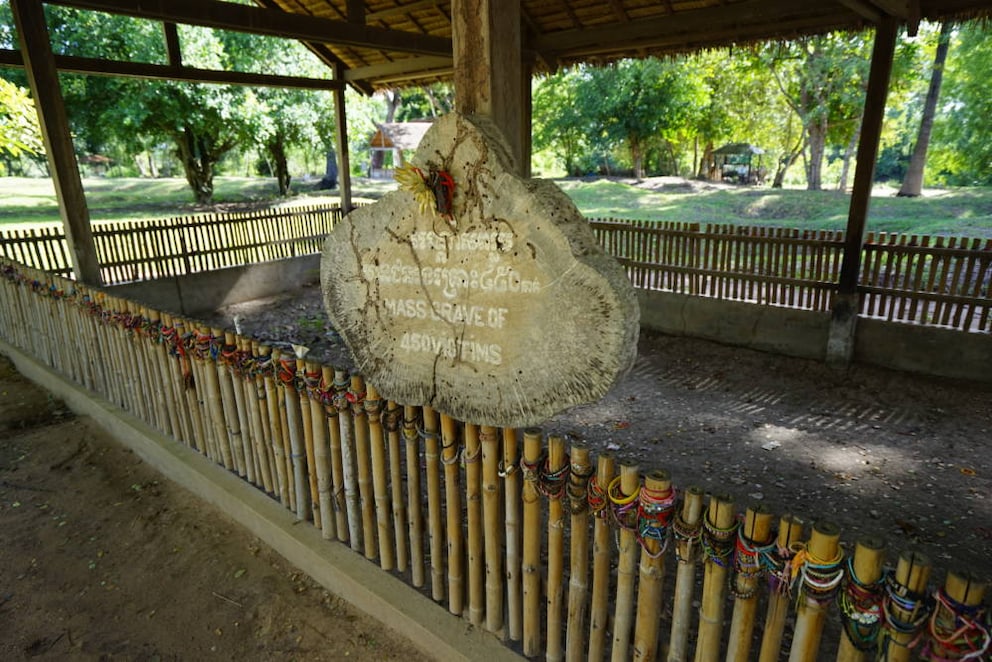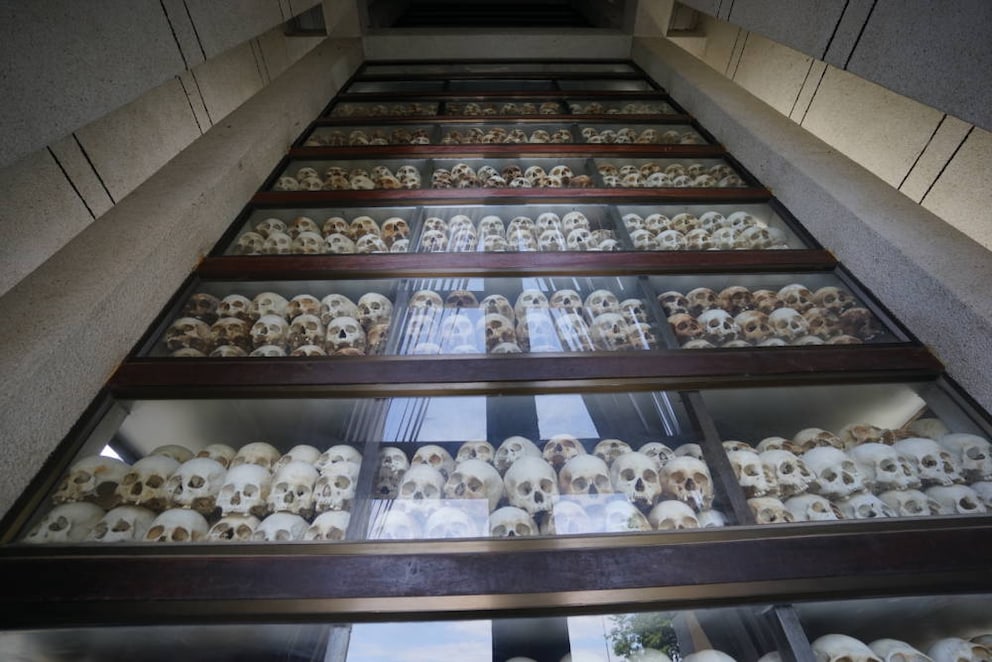January 3, 2025, 11:26 am | Read time: 6 minutes
TRAVELBOOK author Anna Wengel visited the Killing Fields and the former S-21 prison in Cambodia. The terrible history of these places moved her to tears. Especially the tree that is called the “Killing Tree”. It is located in Choeung Ek like a tree-turned-symbol of the atrocities committed by the Khmer Rouge, who killed around 1.7 to 2.2 million Cambodians between 1975 and 1979.
Dizziness. Disgust. Bewilderment. Deep sadness. Who would have thought that a tree could trigger these feelings?
The tree appears utterly ordinary at first glance. A thick, gray-brown trunk, crowned with green foliage. Just like any other tree. If there weren’t hundreds of colorful bracelets hanging from it. And if there wasn’t a sign that tells the story of the “Killing Tree” in Cambodia in seven words, “Killing Tree against which executioners beat children”. The audio guide also tells this story. In more words, although I can’t remember the exact wording. The voice in my ear says something like, “You will now come to a large tree on your right. There were also children and babies among the prisoners. They were silenced at the Killing Tree. Their heads were smashed against the thick tree trunk until the screams ceased and breath was no more.”
Tears well up in my eyes, trickling down my cheeks and dripping onto the path beneath me, refusing to dry up for what seems like an eternity. I sit down; I can’t take my eyes off the tree. I feel sick. It’s not the first time I’ve felt like this today. It won’t be the last time.
Killing Tree on the Largest Killing Field in Cambodia
The “Killing Tree” is located 17 kilometers south of Phnom Penh on the Killing Fields in Choeung Ek, Cambodia. Nearby is a display case under another tree. Clothes are piled up in it. It is the clothing of deceased children and adults whose physical remains are decomposing underground with thousands of others. More than 17,000 people were killed right here during the reign of Pol Pot and his Khmer Rouge. Many of them did not know why.
They wore glasses, spoke a foreign language, were recognized as part of the educated class, and they were exterminated. Suspected enemies of the government of “Democratic Kampuchea”, as Pol Pot called the country. More than one and a half million people fell victim to the genocide. Almost 9,000 bodies have so far been found in the mass graves of Choeung Ek, the best known and largest of the more than 300 Killing Fields in Cambodia. Some of the more than one hundred mass graves have not yet been opened.
“After heavy rainfall, bones and pieces of clothing can sometimes be seen in the earth,” the voice tells me. I automatically take a closer look. I scan the earth for pieces of bone. It has only recently rained. There are indeed small pieces of cloth coming out of the earth here and there.
Wooden walkways and paths lead over and around the layers of earth. A lake lies behind the scene of the murder tree and mass graves. A bench stands in front of it. Some of the mass graves are fenced in by bamboo poles to which visitors have attached numerous colorful bracelets. Plaques provide information about the number of dead who lie here. One of these graves is right next to the tree.

Remains of People Everywhere
The voice leads me on. My feet move along the path, but my thoughts stay in front of the tree. I hardly notice what the voice is saying. The images in my head are too real. The story is too brutal.
Lost in thought, I reach the end of the tour. I step barefoot into the interior of a large white stupa—a building that symbolizes Buddha and his teachings. My shoes stay outside. A huge glass pillar stands here. Filled to the ceiling with thousands of skulls. Eyeless sockets stare back at me, a haunting reminder of lives lost. Small, colorful dots mark them as men, women, girls, and boys of different ages. It is quiet. Frightening somehow, and then calming in an irritating way. I can’t take my eyes off the heads. I stay in the stupa for many minutes. The silence does me good.

From S-21 to the Killing Fields
These are not the first skulls I have seen today. My journey through Cambodia’s recent history began hours earlier at the Tuol Sleng Genocide Museum in Phnom Penh. There is a sign on the ticket booth. It says “No Pokémon”. Just like many other small warnings. The museum is a serious place. A place of remembrance, of memory, of horror. The Tuol Sleng Genocide Museum is the former Khmer Rouge prison S-21. The scene of despair, torture, and death. Pol Pot, Kaing Guek Eav, known as prison chief Duch, and their henchmen imprisoned 12,000 to 20,000 people here during their reign. Many were murdered here, many others were taken to the Killing Fields outside the city. The operators of today’s museum know of only twelve survivors of S-21, according to the information leaflet I receive at the entrance.
Also interesting: Why Cambodia is worth a trip
With a huge group of other tourists and another audio guide on my ears, I walk through the three-story prison blocks and across the sun-soaked forecourt. I see instruments of torture and pictures of how they were used. Cells in which a person can barely sit down, barely lie down. Traces of blood on the floor. Partitions full of information and photos. Photos of women, men, and children. Prison inmates who died here. Photos of people with open eyes who have just died. Skulls of the dead. The voice in my ears keeps telling me what atrocities were committed in this place and how the people felt. Until they felt nothing.

Why Cambodia Is Worth a Trip

Arambol in Goa Is India’s Answer to the Ballermann

Traveling to Emerging Economies? Here’s How to Leave Your Guilt Behind
Cambodia Has Changed
At the end of the day, I step back into the now, paralyzed. Today’s Cambodia still grapples with its past, unable to let go. It constantly reminds itself and everyone who listens of its gruesome history. The museum and mass graves are memorials to how brutal people can be. The “Killing Tree” also stands for this. A symbol of incredible brutality. And of overcoming it. For as scarred as Cambodia is, the country with its many warm-hearted inhabitants has changed—and the “Killing Tree”, too, is a testament to this transformation.
The original of this article was published in 2018.


